Evaluating the Performance of Ozone Products Derived from CrIS/NOAA20, AIRS/Aqua and ERA5 Reanalysis in the Polar Regions in 2020 Using Ground-Based Observations
Abstract
:1. Introduction
2. Data and Method
2.1. Ground-Based Observation
2.2. Satellite Products
2.2.1. NOAA 20 CrIS
2.2.2. AIRS_V7
2.3. ERA5
2.4. Data Selection
2.4.1. Statistical Evaluation Metrics
2.4.2. Coincidence Criteria and Satellite Data Screening
3. Results and Discussion
3.1. TCO Characteristics in Polar Regions
The Inter-Comparison of TCO
3.2. Ozone Profile Characteristics during the Polar Ozone Hole
Comparison with Ozonesonde
4. Conclusions
- (1)
- Insufficient spatial coverage. Firstly, due to some factors—for example, the influence of clouds—the AIRS and CrIS ozone products are unable to cover areas with thick cloud. The difference in algorithm settings regarding quality control also affects the data usage, which leads to a difference in spatial coverage between CrIS and AIRS. In addition, we also found that the number of available observations of CrIS was lower than that of AIRS over the continental area in the polar wintertime and springtime, such as the Antarctic continent in August 2020 and Greenland in January 2020.
- (2)
- Inability to represent ozone profile vertical structure effectively in polar regions. It is difficult for both CrIS and AIRS ozone profiles to capture the strength and location of ozone loss in the vertical direction compared with ozonesonde and ERA5, regardless of whether this is during the ozone or non-ozone loss period. This is related to the low detection sensitivity of thermal infrared techniques. On the other hand, the strong dependence of the ozone retrieval algorithm on a prior profile acquired under low-temperature environmental conditions could also account for this limitation. In addition, other different factors that make measurements of the ozone profile rather challenging in the polar regions, such as the complex and mixed ice, snow, and water surface conditions, especially the sea ice, increase the complexity of the surface parameters that can be characterized by retrieval algorithms.
Supplementary Materials
Author Contributions
Funding
Institutional Review Board Statement
Informed Consent Statement
Data Availability Statement
Acknowledgments
Conflicts of Interest
References
- Son, S.-W.; Polvani, L.M.; Waugh, D.W.; Akiyoshi, H.; Garcia, R.; Kinnison, D.; Pawson, S.; Rozanov, E.; Shepherd, T.G.; Shibata, K. The impact of stratospheric ozone recovery on the southern hemisphere westerly jet. Science 2008, 320, 1486–1489. [Google Scholar] [CrossRef]
- Shindell, D.; Rind, D.; Balachandran, N.; Lean, J.; Lonergan, P. Solar cycle variability, ozone, and climate. Science 1999, 284, 305–308. [Google Scholar] [CrossRef] [Green Version]
- Xie, F.; Tian, W.; Chipperfield, M.P. Radiative effect of ozone change on stratosphere-troposphere exchange. J. Geophys. Res. Atmos. 2008, 113, 113. [Google Scholar] [CrossRef] [Green Version]
- Zhang, J.; Tian, W.; Xie, F.; Pyle, J.A.; Keeble, J.; Wang, T. The influence of zonally asymmetric stratospheric ozone changes on the arctic polar vortex shift. J. Clim. 2020, 33, 4641–4658. [Google Scholar] [CrossRef] [Green Version]
- Sillman, S. The relation between ozone, NOx and hydrocarbons in urban and polluted rural environments. Atmos. Environ. 1999, 33, 1821–1845. [Google Scholar] [CrossRef]
- Monks, P.S.; Archibald, A.T.; Colette, A.; Cooper, O.; Coyle, M.; Derwent, R.; Fowler, D.; Granier, C.; Law, K.S.; Mills, G.E.; et al. Tropospheric ozone and its precursors from the urban to the global scale from air quality to short-lived climate forcer. Atmos. Chem. Phys. 2015, 15, 8889–8973. [Google Scholar] [CrossRef] [Green Version]
- Deshler, T.; Mercer, J.L.; Smit, H.G.J.; Stubi, R.; Levrat, G.; Johnson, B.J.; Oltmans, S.J.; Kivi, R.; Thompson, A.M.; Witte, J.; et al. Atmospheric comparison of electrochemical cell ozonesondes from different manufacturers, and with different cathode solution strengths: The balloon experiment on standards for ozonesondes. J. Geophys. Res. Atmos. 2008, 113. [Google Scholar] [CrossRef]
- Tarasick, D.W.; Smit, H.G.J.; Thompson, A.M.; Morris, G.A.; Witte, J.C.; Davies, J.; Nakano, T.; Van Malderen, R.; Stauffer, R.M.; Johnson, B.J.; et al. Improving ECC ozonesonde data quality: Assessment of current methods and outstanding issues. Earth Space Sci. 2021, 8. [Google Scholar] [CrossRef]
- Komhyr, W.D.; Grass, R.D.; Leonard, R.K. Dobson spectrophotometer 83: A standard for total ozone measurements, 1962–1987. J. Geophys. Res. Atmos. 1989, 94, 9847–9861. [Google Scholar] [CrossRef]
- Balis, D.; Kroon, M.; Koukouli, M.E.; Brinksma, E.J.; Labow, G.; Veefkind, J.P.; McPeters, R.D. Validation of Ozone Monitoring Instrument total ozone column measurements using Brewer and Dobson spectrophotometer ground-based observations. J. Geophys. Res. Atmos. 2007, 112. [Google Scholar] [CrossRef] [Green Version]
- Kerr, J.B.; Asbridge, I.A.; Evans, W.F.J. Intercomparison of total ozone measured by the Brewer and Dobson spectrophotometers at Toronto. J. Geophys. Res. Atmos. 1988, 93, 11129–11140. [Google Scholar] [CrossRef]
- Sullivan, J.T.; McGee, T.J.; Sumnicht, G.K.; Twigg, L.W.; Hoff, R.M. A mobile differential absorption lidar to measure sub-hourly fluctuation of tropospheric ozone profiles in the Baltimore-Washington, DC region. Atmos. Meas. Tech. 2014, 7, 3529–3548. [Google Scholar] [CrossRef] [Green Version]
- Wang, L.; Newchurch, M.J.; Alvarez, R.J., II; Berkoff, T.A.; Brown, S.S.; Carrion, W.; De Young, R.J.; Johnson, B.J.; Ganoe, R.; Gronoff, G.; et al. Quantifying TOLNet ozone lidar accuracy during the 2014 DISCOVER-AQ and FRAPPE campaigns. Atmos. Meas. Tech. 2017, 10, 3865–3876. [Google Scholar] [CrossRef] [PubMed] [Green Version]
- Gelaro, R.; McCarty, W.; Suárez, M.J.; Todling, R.; Molod, A.; Takacs, L.; Randles, C.A.; Darmenov, A.; Bosilovich, M.G.; Reichle, R.; et al. The modern-era retrospective analysis for research and applications, version 2 (MERRA-2). J. Clim. 2017, 30, 5419–5454. [Google Scholar] [CrossRef]
- Inness, A.; Ades, M.; Agusti-Panareda, A.; Barre, J.; Benedictow, A.; Blechschmidt, A.-M.; Dominguez, J.J.; Engelen, R.; Eskes, H.; Flemming, J.; et al. The CAMS reanalysis of atmospheric composition. Atmos. Chem. Phys. 2019, 19, 3515–3556. [Google Scholar] [CrossRef] [Green Version]
- Hersbach, H.; Bell, B.; Berrisford, P.; Hirahara, S.; Horanyi, A.; Munoz-Sabater, J.; Nicolas, J.; Peubey, C.; Radu, R.; Schepers, D.; et al. The ERA5 global reanalysis. Q. J. R. Meteorol. Soc. 2020, 146, 1999–2049. [Google Scholar] [CrossRef]
- Fujiwara, M.; Wright, J.S.; Manney, G.L.; Gray, L.J.; Anstey, J.; Birner, T.; Davis, S.; Gerber, E.P.; Harvey, V.L.; Hegglin, M.I.; et al. Introduction to the SPARC Reanalysis Intercomparison Project (S-RIP) and overview of the reanalysis systems. Atmos. Chem. Phys. 2017, 17, 1417–1452. [Google Scholar] [CrossRef] [Green Version]
- Molod, A.; Takacs, L.; Suarez, M.; Bacmeister, J. Development of the GEOS-5 atmospheric general circulation model: Evolution from MERRA to MERRA2. Geosci. Model Dev. 2015, 8, 1339–1356. [Google Scholar] [CrossRef] [Green Version]
- Kobayashi, S.; Ota, Y.; Harada, Y.; Ebita, A.; Moriya, M.; Onoda, H.; Onogi, K.; Kamahori, H.; Kobayashi, C.; Endo, H.; et al. The JRA-55 reanalysis: General specifications and basic characteristics. J. Meteorol. Soc. Jpn. Ser. II 2015, 93, 5–48. [Google Scholar] [CrossRef] [Green Version]
- Wargan, K.; Labow, G.; Frith, S.; Pawson, S.; Livesey, N.; Partyka, G. Evaluation of the ozone fields in NASA’s MERRA-2 reanalysis. J. Clim. 2017, 30, 2961–2988. [Google Scholar] [CrossRef] [Green Version]
- Dethof, A.; Holm, E.V. Ozone assimilation in the ERA-40 reanalysis project. Q. J. R. Meteorol. Soc. 2004, 130, 2851–2872. [Google Scholar] [CrossRef]
- Dragani, R. On the quality of the ERA-Interim ozone reanalyses: Comparisons with satellite data. Q. J. R. Meteorol. Soc. 2011, 137, 1312–1326. [Google Scholar] [CrossRef]
- Ziemke, J.R.; Olsen, M.A.; Witte, J.C.; Douglass, A.R.; Strahan, S.E.; Wargan, K.; Liu, X.; Schoeberl, M.R.; Yang, K.; Kaplan, T.B.; et al. Assessment and applications of NASA ozone data products derived from Aura OMI/MLS satellite measurements in context of the GMI chemical transport model. J. Geophys. Res. Atmos. 2014, 119, 5671–5699. [Google Scholar] [CrossRef]
- Orr, A.; Lu, H.; Martineau, P.; Gerber, E.P.; Marshall, G.J.; Bracegirdle, T.J. Is our dynamical understanding of the circulation changes associated with the Antarctic ozone hole sensitive to the choice of reanalysis dataset? Atmos. Chem. Phys. 2021, 21, 7451–7472. [Google Scholar] [CrossRef]
- Inness, A.; Chabrillat, S.; Flemming, J.; Huijnen, V.; Langenrock, B.; Nicolas, J.; Polichtchouk, I.; Razinger, M. Exceptionally low arctic stratospheric ozone in spring 2020 as seen in the CAMS reanalysis. J. Geophys. Res. Atmos. 2020, 125, 125. [Google Scholar] [CrossRef]
- Solomon, S.; Garcia, R.R.; Rowland, F.S.; Wuebbles, D.J. On the depletion of Antarctic ozone. Nature 1986, 321, 755–758. [Google Scholar] [CrossRef] [Green Version]
- Langematz, U.; Tully, M.; Calvo, N.; Dameris, M.; Young, P. Polar Stratospheric Ozone: Past, Present, and Future Chapter 4 in WMO Scientific Assessment of Ozone Depletion: 2018; German Aerospace Center: Cologne, Germany, 2018. [Google Scholar]
- Chipperfield, M.P.; Bekki, S.; Dhomse, S.; Harris, N.R.P.; Hassler, B.; Hossaini, R.; Steinbrecht, W.; Thieblemont, R.; Weber, M. Detecting recovery of the stratospheric ozone layer. Nature 2017, 549, 211–218. [Google Scholar] [CrossRef] [PubMed] [Green Version]
- Solomon, S.; Haskins, J.; Ivy, D.J.; Min, F. Fundamental differences between Arctic and Antarctic ozone depletion. Proc. Natl. Acad. Sci. USA 2014, 111, 6220–6225. [Google Scholar] [CrossRef] [Green Version]
- Solomon, S.; Kinnison, D.; Bandoro, J.; Garcia, R. Simulation of polar ozone depletion: An update. J. Geophys. Res. Atmos. 2015, 120, 7958–7974. [Google Scholar] [CrossRef]
- Manney, G.L.; Santee, M.L.; Rex, M.; Livesey, N.J.; Pitts, M.C.; Veefkind, P.; Nash, E.R.; Wohltmann, I.; Lehmann, R.; Froidevaux, L.; et al. Unprecedented Arctic ozone loss in 2011. Nature 2011, 478, 469–475. [Google Scholar] [CrossRef] [PubMed]
- Feng, W.; Dhomse, S.S.; Arosio, C.; Weber, M.; Burrows, J.P.; Santee, M.L.; Chipperfield, M.P. Arctic ozone depletion in 2019/20: Roles of chemistry, dynamics and the Montreal Protocol. Geophys. Res. Lett. 2021, 48. [Google Scholar] [CrossRef]
- Lawrence, Z.D.; Perlwitz, J.; Butler, A.H.; Manney, G.L.; Newman, P.A.; Lee, S.H.; Nash, E.R. The remarkably strong Arctic stratospheric polar vortex of winter 2020: Links to record-breaking Arctic oscillation and ozone loss. J. Geophys. Res. Atmos. 2020, 125. [Google Scholar] [CrossRef]
- Stolarski, R.S.; McPeters, R.D.; Newman, P.A. The ozone hole of 2002 as measured by TOMS. J. Atmos. Sci. 2005, 62, 716–720. [Google Scholar] [CrossRef]
- Weber, M.; Arosio, C.; Feng, W.; Dhomse, S.S.; Chipperfield, M.P.; Meier, A.; Burrows, J.P.; Eichmann, K.-U.; Richter, A.; Rozanov, A. The unusual stratospheric arctic winter 2019/20: Chemical ozone loss from satellite observations and TOMCAT chemical transport model. J. Geophys. Res. Atmos. 2021, 126. [Google Scholar] [CrossRef]
- Dameris, M.; Loyola, D.G.; Nutzel, M.; Coldewey-Egbers, M.; Lerot, C.; Romahn, F.; van Roozendael, M. Record low ozone values over the Arctic in boreal spring 2020. Atmos. Chem. Phys. 2021, 21, 617–633. [Google Scholar] [CrossRef]
- Rao, J.; Garfinkel, C.I. Arctic ozone loss in March 2020 and its seasonal prediction in CFSv2: A comparative study with the 1997 and 2011 cases. J. Geophys. Res. Atmos. 2020, 125, 125. [Google Scholar] [CrossRef]
- DeLand, M.T.; Bhartia, P.K.; Kramarova, N.; Chen, Z. OMPS LP Observations of PSC variability during the NH 2019-2020 season. Geophys. Res. Lett. 2020, 47, 47. [Google Scholar] [CrossRef]
- Manney, G.L.; Livesey, N.J.; Santee, M.L.; Froidevaux, L.; Lambert, A.; Lawrence, Z.D.; Millan, L.F.; Neu, J.L.; Read, W.G.; Schwartz, M.J.; et al. Record-low Arctic stratospheric ozone in 2020: MLS Observations of chemical processes and comparisons with previous extreme winters. Geophys. Res. Lett. 2020, 47. [Google Scholar] [CrossRef]
- Hu, Y. The very unusual polar stratosphere in 2019–2020. Sci. Bull. 2020, 65, 1775–1777. [Google Scholar] [CrossRef]
- Zhang, L.; Ding, M.; Bian, L.; Li, J. Validation of AIRS temperature and ozone profiles over Antarctica. Chin. J. Geophys. Chin. Ed. 2020, 63, 1318–1331. [Google Scholar] [CrossRef]
- Smith, N.; Barnet, C.D. CLIMCAPS observing capability for temperature, moisture, and trace gases from AIRS/AMSU and CrIS/ATMS. Atmos. Meas. Tech. 2020, 13, 4437–4459. [Google Scholar] [CrossRef]
- Boynard, A.; Hurtmans, D.; Garane, K.; Goutail, F.; Hadji-Lazaro, J.; Koukouli, M.E.; Wespes, C.; Vigouroux, C.; Keppens, A.; Pommereau, J.-P.; et al. Validation of the IASI FORLI/EUMETSAT ozone products using satellite (GOME-2), ground-based (Brewer-Dobson, SAOZ, FTIR) and ozonesonde measurements. Atmos. Meas. Tech. 2018, 11, 5125–5152. [Google Scholar] [CrossRef] [Green Version]
- Yue, Q.; Lambrigtsen, B. AIRS Version 7 Level 2 Performance Test and Validation Report; Jet Propulsion Laboratory, California Institute of Technology: Pasadena, CA, USA, 2020. [Google Scholar]
- Thrastarson, H.T.; Olsen, E.T. AIRS/AMSU/HSB Version 7 Level 2 Quality Control and Error Estimation; Jet Propulsion Laboratory, California Institute of Technology: Pasadena, CA, USA, 2020. [Google Scholar]
- Kim, J.; Kim, J.; Cho, H.K.; Herman, J.; Park, S.S.; Lim, H.K.; Kim, J.H.; Miyagawa, K.; Lee, Y.G. Intercomparison of total column ozone data from the Pandora spectrophotometer with Dobson, Brewer, and OMI measurements over Seoul, Korea. Atmos. Meas. Tech. 2017, 10, 3661–3676. [Google Scholar] [CrossRef] [Green Version]
- Garane, K.; Koukouli, M.-E.; Verhoelst, T.; Lerot, C.; Heue, K.-P.; Fioletov, V.; Balis, D.; Bais, A.; Bazureau, A.; Dehn, A.; et al. TROPOMI/S5P total ozone column data: Global ground-based validation and consistency with other satellite missions. Atmos. Meas. Tech. 2019, 12, 5263–5287. [Google Scholar] [CrossRef] [Green Version]
- Nalli, N.R.; Gambacorta, A.; Liu, Q.; Tan, C.; Iturbide-Sanchez, F.; Barnet, C.D.; Joseph, E.; Morris, V.R.; Oyola, M.; Smith, J.W. Validation of atmospheric profile retrievals from the SNPP NOAA-unique combined atmospheric processing system. Part 2: Ozone. IEEE Trans. Geosci. Remote Sens. 2018, 56, 598–607. [Google Scholar] [CrossRef]
- Nassar, R.; Logan, J.A.; Worden, H.M.; Megretskaia, I.A.; Bowman, K.W.; Osterman, G.B.; Thompson, A.M.; Tarasick, D.W.; Austin, S.; Claude, H.; et al. Validation of Tropospheric Emission Spectrometer (TES) nadir ozone profiles using ozonesonde measurements. J. Geophys. Res. Atmos. 2008, 113. [Google Scholar] [CrossRef] [Green Version]
- Smith, N.; Barnet, C.D. Uncertainty Characterization and Propagation in the Community Long-Term Infrared Microwave Combined Atmospheric Product System (CLIMCAPS). Remote Sens. 2019, 11, 1227. [Google Scholar] [CrossRef] [Green Version]
- Gambacorta, A.; Barnet, C.D. Methodology and information content of the NOAA NESDIS operational channel selection for the Cross-Track Infrared Sounder (CrIS). IEEE Trans. Geosci. Remote Sens. 2013, 51, 3207–3216. [Google Scholar] [CrossRef]
- Susskind, J.; Blaisdell, J.M.; Iredell, L.; Keita, F. Improved Temperature sounding and quality control methodology using AIRS/AMSU Data: The AIRS Science Team version 5 retrieval algorithm. IEE Trans. Geosci. Remote Sens. 2011, 49, 883–907. [Google Scholar] [CrossRef] [Green Version]
- Aumann, H.H.; Chahine, M.T.; Gautier, C.; Goldberg, M.D.; Kalnay, E.; McMillin, L.M.; Revercomb, H.; Rosenkranz, P.W.; Smith, W.L.; Staelin, D.H.; et al. AIRS/AMSU/HSB on the aqua mission: Design, science objectives, data products, and processing systems. IEEE Trans. Geosci. Remote Sens. 2003, 41, 253–264. [Google Scholar] [CrossRef] [Green Version]
- Milstein, A.B.; Blackwell, W.J. Neural network temperature and moisture retrieval algorithm validation for AIRS/AMSU and CrIS/ATMS. J. Geophys. Res. Atmos. 2016, 121, 1414–1430. [Google Scholar] [CrossRef] [Green Version]
- Thrastarson, H.T.; Olsen, E.T. AIRS Version 7 Retrieval Channel Sets; Jet Propulsion Laboratory, California Institute of Technology: Pasadena, CA, USA, 2020. [Google Scholar]
- Susskind, J.; Blaisdell, J.M.; Iredell, L. Improved methodology for surface and atmospheric soundings, error estimates, and quality control procedures: The atmospheric infrared sounder science team version-6 retrieval algorithm. J. Appl. Remote Sens. 2014, 8. [Google Scholar] [CrossRef]
- Cariolle, D.; Teyssedre, H. A revised linear ozone photochemistry parameterization for use in transport and general circulation models: Multi-annual simulations. Atmos. Chem. Phys. 2007, 7, 2183–2196. [Google Scholar] [CrossRef] [Green Version]
- Chylek, P.; Folland, C.K.; Lesins, G.; Dubey, M.K.; Wang, M. Arctic air temperature change amplification and the Atlantic Multidecadal Oscillation. Geophys. Res. Lett. 2009, 36. [Google Scholar] [CrossRef] [Green Version]
- Crewell, S.; Ebell, K.; Konjari, P.; Mech, M.; Nomokonova, T.; Radovan, A.; Strack, D.; Triana-Gomez, A.M.; Noel, S.; Scarlat, R.; et al. A systematic assessment of water vapor products in the Arctic: From instantaneous measurements to monthly means. Atmos. Meas. Tech. 2021, 14, 4829–4856. [Google Scholar] [CrossRef]
- You, Q.; Cai, Z.; Pepin, N.; Chen, D.; Ahrens, B.; Jiang, Z.; Wu, F.; Kang, S.; Zhang, R.; Wu, T.; et al. Warming amplification over the Arctic Pole and Third Pole: Trends, mechanisms and consequences. Earth Sci. Rev. 2021, 217. [Google Scholar] [CrossRef]
- Przybylak, R. Changes in seasonal and annual high-frequency air temperature variability in the Arctic from 1951 to 1990. Int. J. Climatol. 2002, 22, 1017–1032. [Google Scholar] [CrossRef]
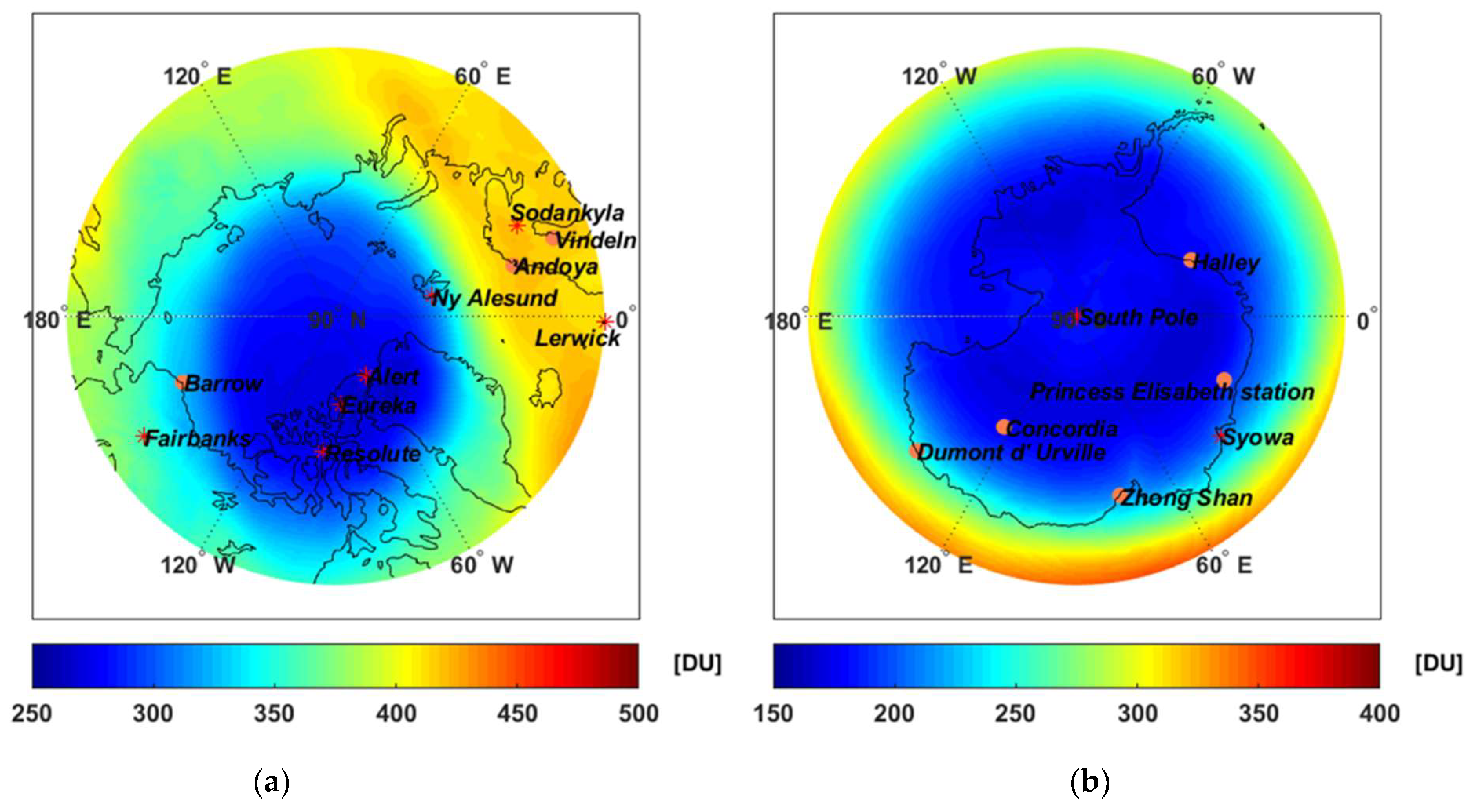
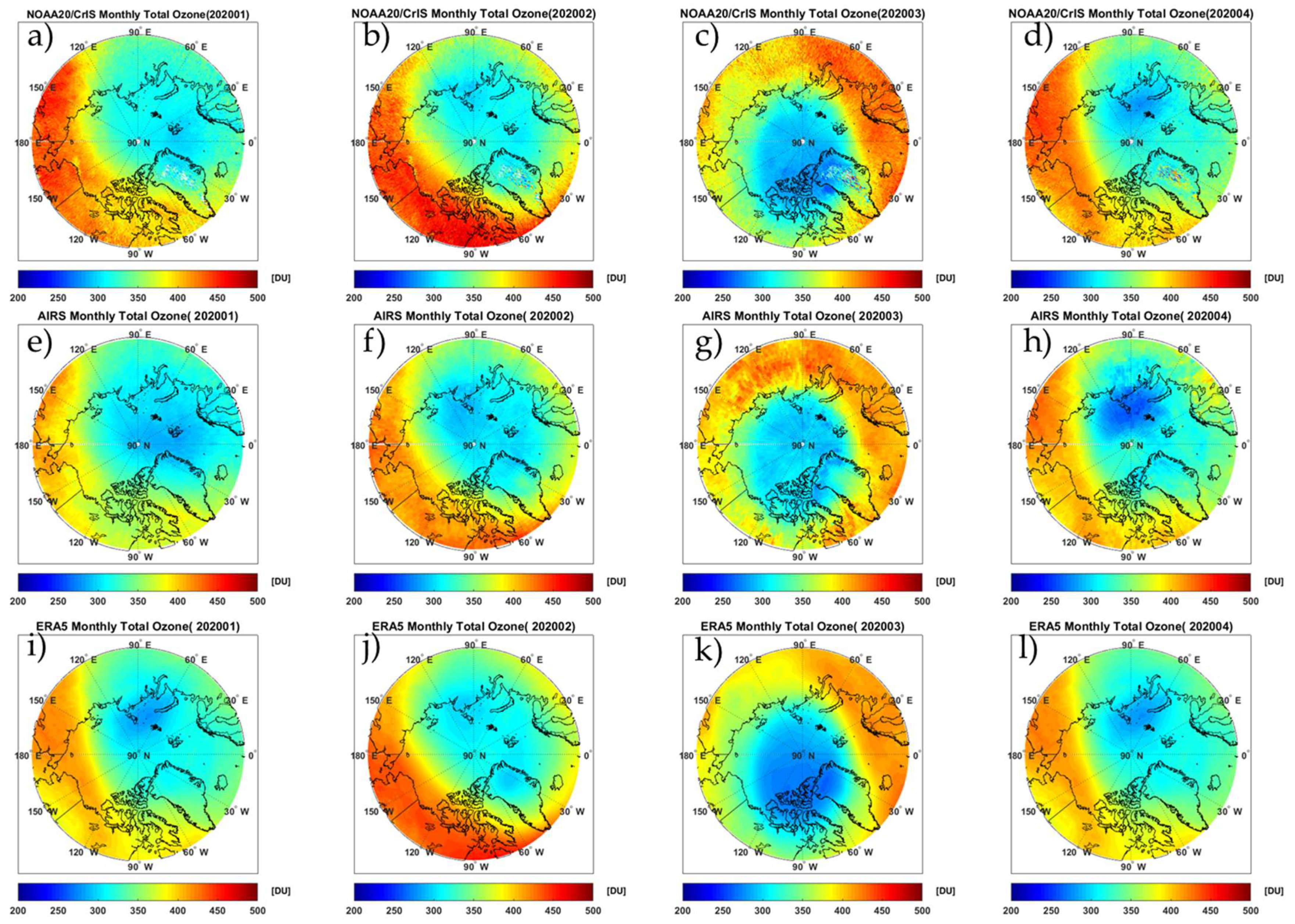
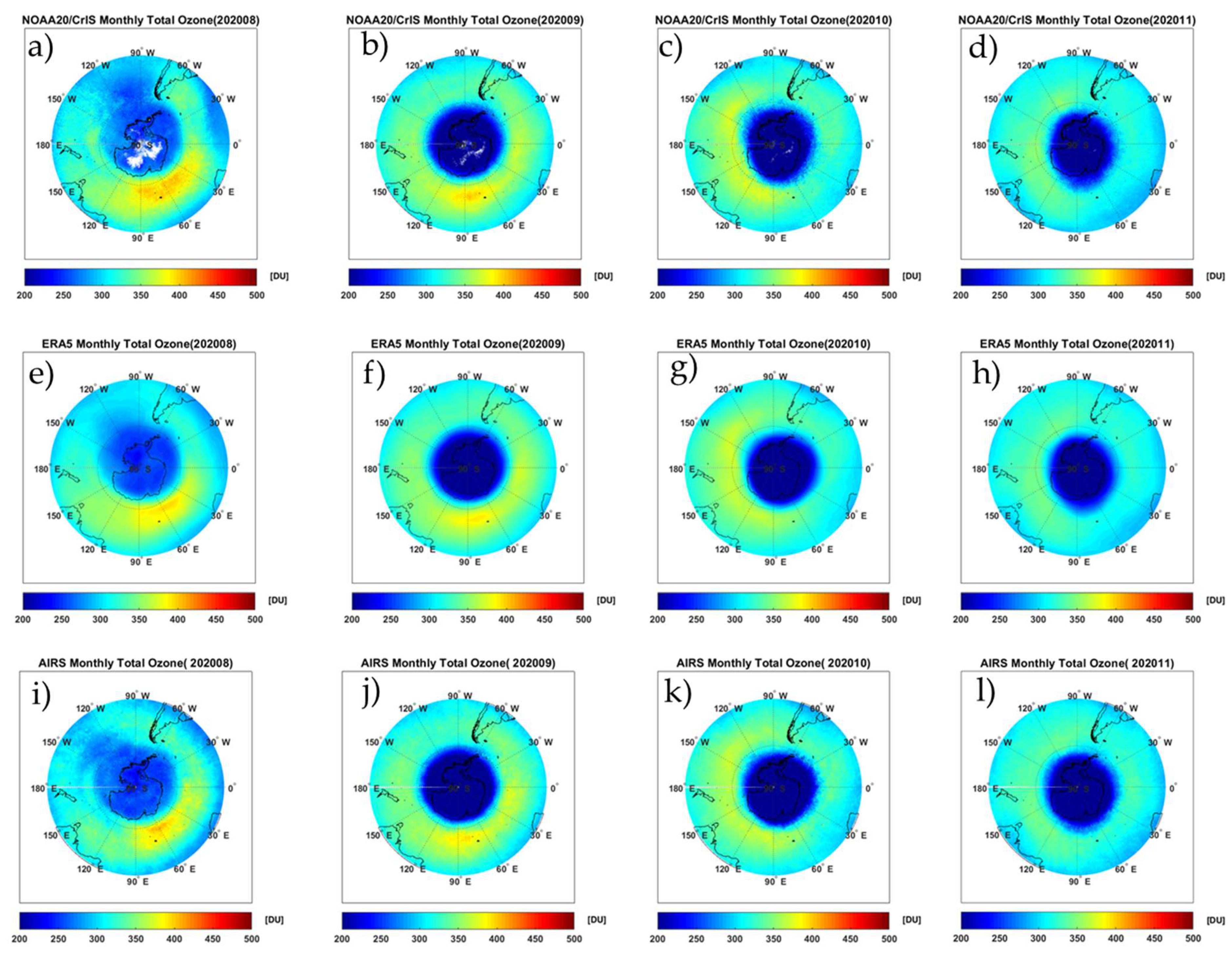
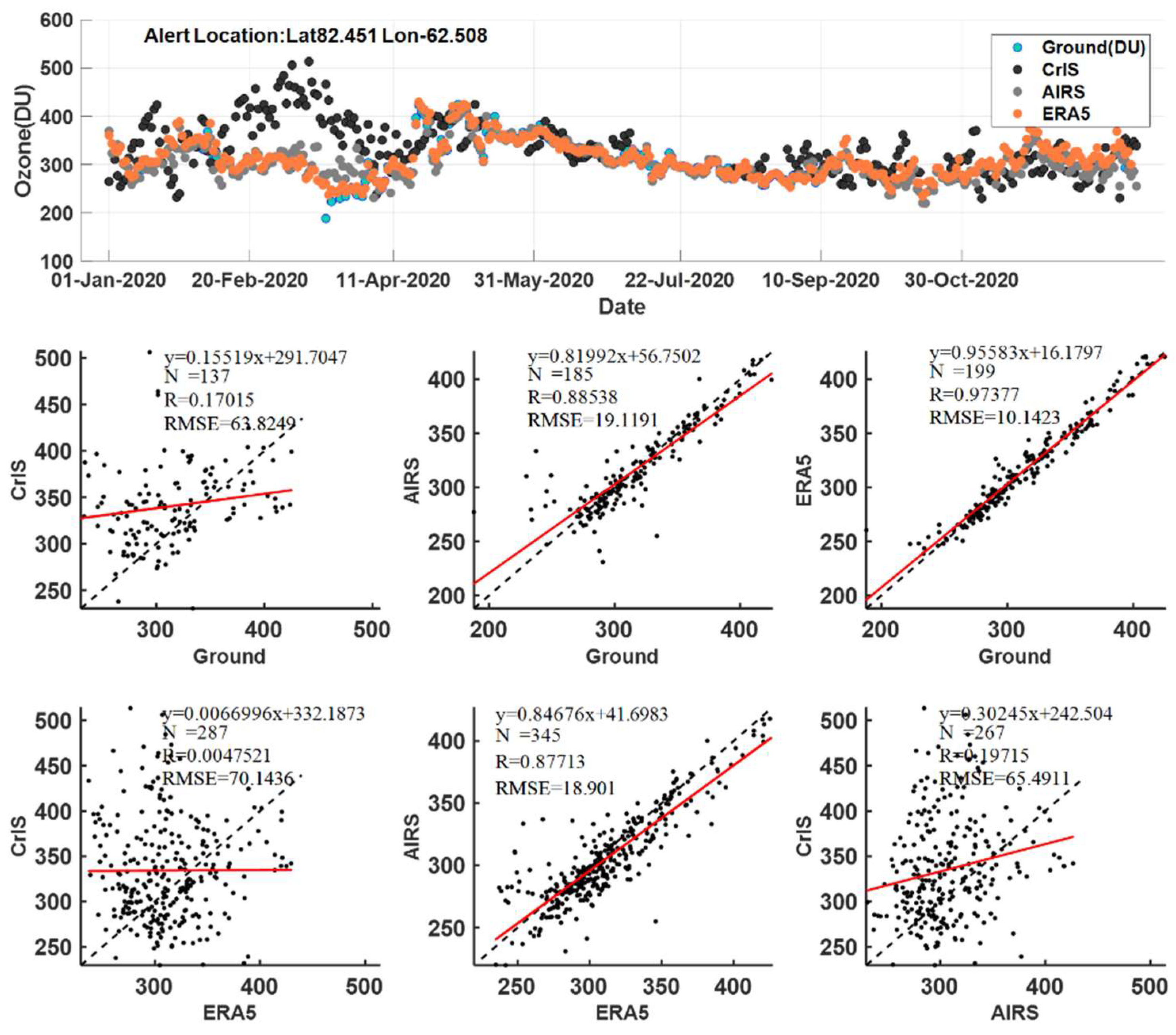

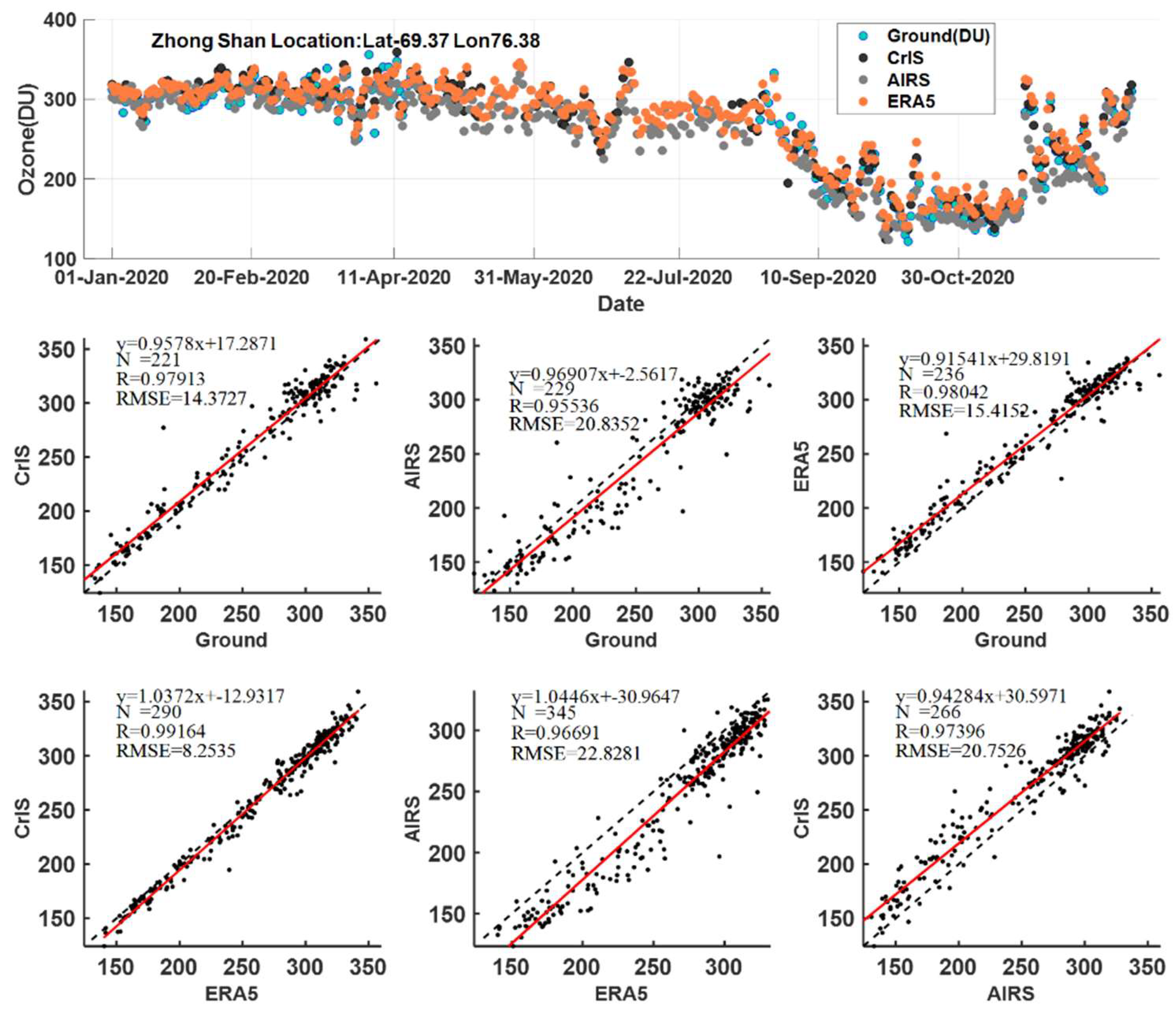
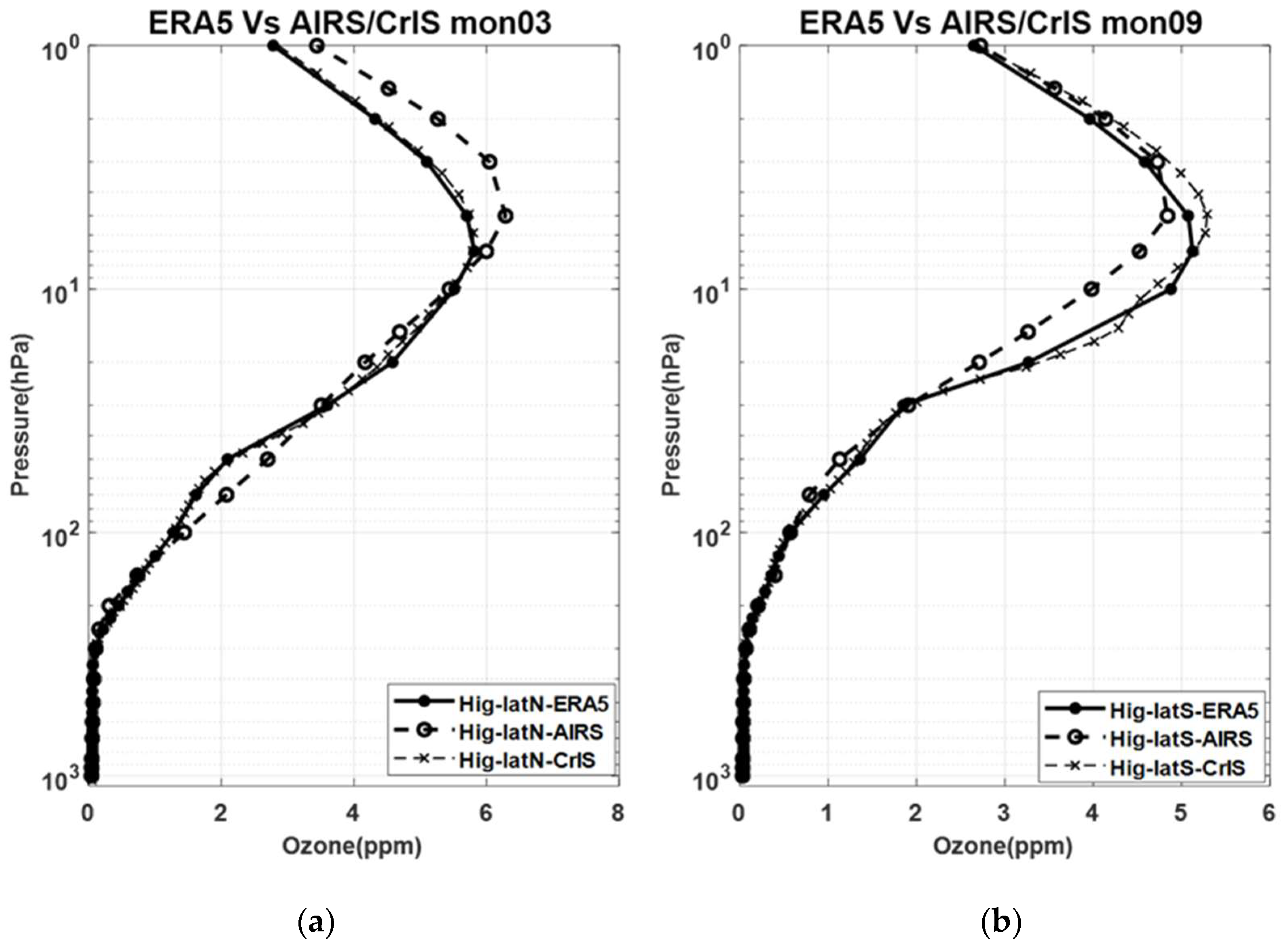
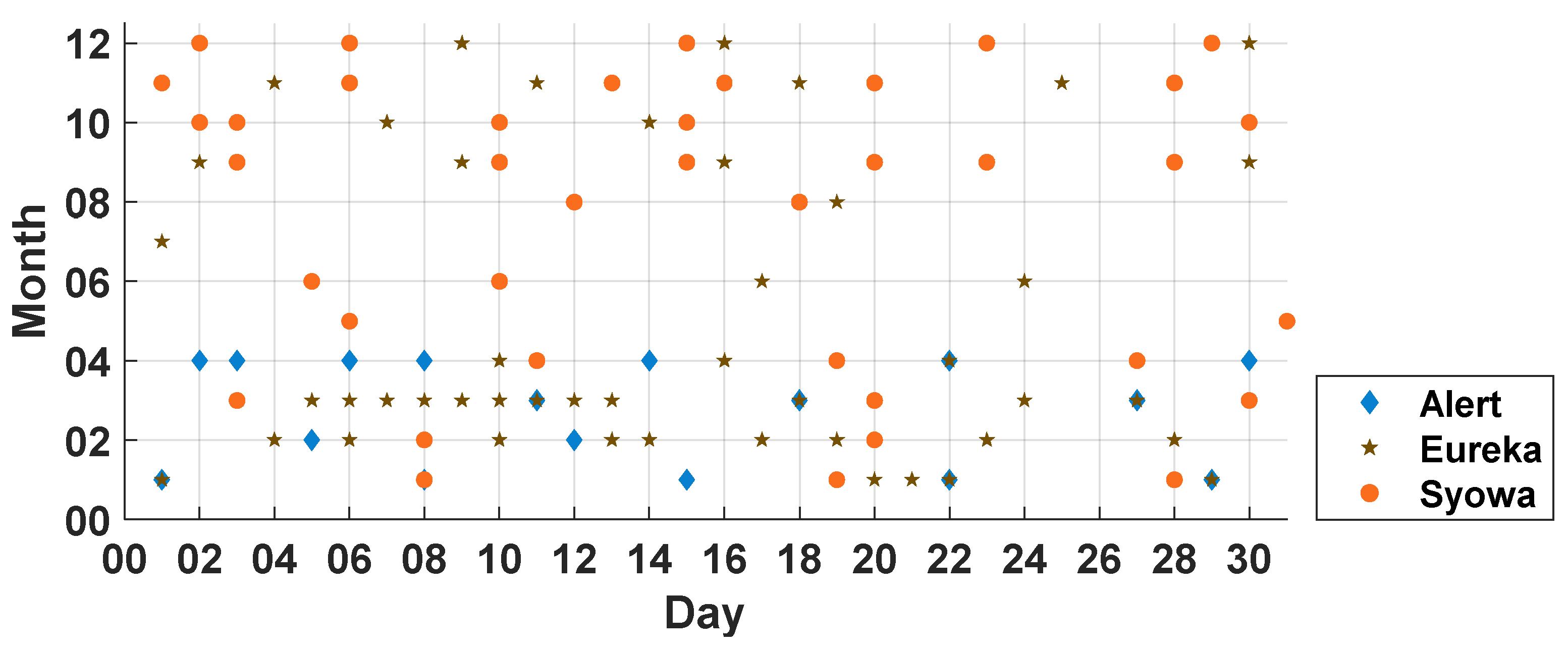
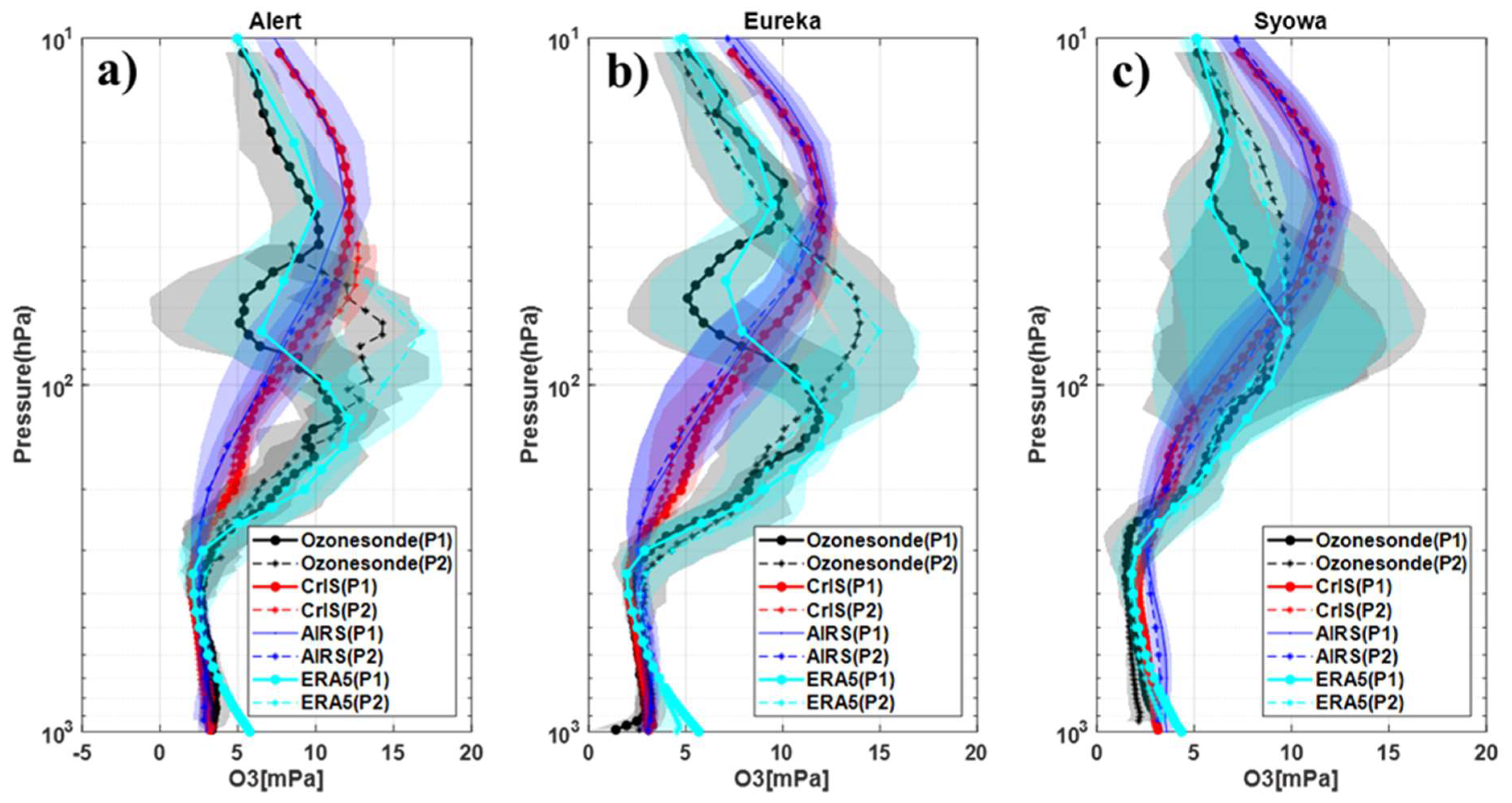
| No. | Site_ID | Site_Name | Latitude | Longitude | Instrument | T_start | T_end |
|---|---|---|---|---|---|---|---|
| 1 | stn478 | Zhong Shan | −69.3700 | 76.3700 | Brewer | 1993.03 | 2021.03 |
| 2 | stn057 | Halley | −75.6200 | −26.1800 | Dobson | 1957.06 | 2020.09 |
| 3 | stn028 | Dumont d’Urville | −66.6629 | 140.0025 | Saoz | 1988.02 | 2020.12 |
| 4 | stn499 | Princess Elisabeth station | −71.9500 | 23.3500 | Brewer | 2011.01 | 2021.02 |
| 5 | stn492 | Concordia | −75.1000 | 123.3000 | Saoz | 2007.01 | 2020.11 |
| 6 | stn199 | Barrow (AK) | 71.3230 | −156.6115 | Dobson | 1973.07 | 2020.10 |
| 7 | stn284 | Vindeln | 64.2333 | 19.7667 | Brewer | 1996.06 | 2021.05 |
| Dobson | 1963.12 | 2021.05 | |||||
| 8 | stn476 | Andoya | 69.2785 | 16.0093 | Dobson | 2000.03 | 2020.10 |
| 9 | stn111 | South Pole | −89.9969 | −24.8000 | Brewer | 2008.02 | 2021.04 |
| Dobson | 1963.12 | 2020.12 | |||||
| Carbon-iodine | 1966.03 | 1966.12 | |||||
| regener | 1962.03 | 1966.01 | |||||
| Undefined sondes | 1967.11 | 1987.11 | |||||
| 10 | stn101 | Syowa | −69.0000 | 39.5833 | Dobson | 1961.03 | 2021.04 |
| Carbon-iodine | 1966.03 | 2010.03 | |||||
| ECC | 2010.04 | 2021.04 | |||||
| 11 | stn262 | Sodankylä | 67.3638 | 26.6304 | Saoz | 1990.20 | 2020.12 |
| Brewer | 1988.05 | 2010.05 | |||||
| ECC | 1988.03 | 2006.09 | |||||
| 12 | stn043 | Lerwick | 60.1333 | −1.1833 | Dobson | 1952.06 | 2021.05 |
| ECC | 1992.02 | 2016.12 | |||||
| 13 | stn018 | Alert | 82.4991 | −62.3415 | Dobson | 1957.07 | 1958.11 |
| Brewer | 1987.10 | 2021.04 | |||||
| ECC | 1987.12 | 2020.12 | |||||
| 14 | stn105 | Fairbanks (AK) | 64.8200 | −147.8700 | Dobson | 1965.02 | 2020.10 |
| Carbon-iodine | 1965.10 | 1965.12 | |||||
| regener | 1964.11 | 1965.09 | |||||
| 15 | stn024 | Resolute | 74.7167 | −94.9833 | Dobson | 1957.07 | 1990.08 |
| Brewer | 1987.05 | 2021.04 | |||||
| ECC | 1978.05 | 2019.12 | |||||
| Brewer-Mast | 1966.01 | 1979.11 | |||||
| 16 | stn315 | Eureka | 80.0500 | −86.4167 | Brewer | 2001.01 | 2021.04 |
| ECC | 1992.11 | 2021.03 | |||||
| 17 | stn089 | Ny Alesund | 78.9236 | 11.9237 | Dobson | 1966.11 | 1997.04 |
| Brewer | 2007.05 | 2021.02 | |||||
| ECC | 1990.10 | 2013.07 |
| Alert | Ground | AIRS(V7) | ERA5 | |
|---|---|---|---|---|
| CrIS | R | 0.17 | 0.2 | 0 |
| RMSE | 63.82 | 65.49 | 70.14 | |
| N | 137 | 267 | 287 | |
| AIRS(V7) | R | 0.89 | 0.88 | |
| RMSE | 19.12 | 18.9 | ||
| N | 185 | 345 | ||
| ERA5 | R | 0.97 | ||
| RMSE | 10.14 | |||
| N | 199 | |||
| Lerwick | ||||
| CrIS | R | 0.93 | 0.97 | 0.96 |
| RMSE | 20.71 | 12.67 | 15.3 | |
| N | 202 | 284 | 287 | |
| AIRS(V7) | R | 0.92 | 0.95 | |
| RMSE | 19.94 | 16.89 | ||
| N | 233 | 345 | ||
| ERA5 | R | 0.96 | ||
| RMSE | 15.23 | |||
| N | 232 | |||
| Zhongshan | ||||
| CrIS | R | 0.98 | 0.97 | 0.99 |
| RMSE | 14.37 | 20.75 | 8.25 | |
| N | 221 | 266 | 290 | |
| AIRS(V7) | R | 0.95 | 0.96 | |
| RMSE | 20.84 | 22.83 | ||
| N | 229 | 345 | ||
| ERA5 | R | 0.98 | ||
| RMSE | 15.42 | |||
| N | 236 | |||
| P1 | P2 | |||
|---|---|---|---|---|
| Period | Num | Num | ||
| Alert | 1 March 2020~30 April 2020 | 10 | _ | 7 |
| Eureka | 1 March 2020~30 April 2020 | 16 | _ | 38 |
| Syowa | 1 September 2020~30 October 2020 | 11 | _ | 28 |
Publisher’s Note: MDPI stays neutral with regard to jurisdictional claims in published maps and institutional affiliations. |
© 2021 by the authors. Licensee MDPI, Basel, Switzerland. This article is an open access article distributed under the terms and conditions of the Creative Commons Attribution (CC BY) license (https://creativecommons.org/licenses/by/4.0/).
Share and Cite
Wang, H.; Wang, Y.; Cai, K.; Zhu, S.; Zhang, X.; Chen, L. Evaluating the Performance of Ozone Products Derived from CrIS/NOAA20, AIRS/Aqua and ERA5 Reanalysis in the Polar Regions in 2020 Using Ground-Based Observations. Remote Sens. 2021, 13, 4375. https://doi.org/10.3390/rs13214375
Wang H, Wang Y, Cai K, Zhu S, Zhang X, Chen L. Evaluating the Performance of Ozone Products Derived from CrIS/NOAA20, AIRS/Aqua and ERA5 Reanalysis in the Polar Regions in 2020 Using Ground-Based Observations. Remote Sensing. 2021; 13(21):4375. https://doi.org/10.3390/rs13214375
Chicago/Turabian StyleWang, Hongmei, Yapeng Wang, Kun Cai, Songyan Zhu, Xinxin Zhang, and Liangfu Chen. 2021. "Evaluating the Performance of Ozone Products Derived from CrIS/NOAA20, AIRS/Aqua and ERA5 Reanalysis in the Polar Regions in 2020 Using Ground-Based Observations" Remote Sensing 13, no. 21: 4375. https://doi.org/10.3390/rs13214375
APA StyleWang, H., Wang, Y., Cai, K., Zhu, S., Zhang, X., & Chen, L. (2021). Evaluating the Performance of Ozone Products Derived from CrIS/NOAA20, AIRS/Aqua and ERA5 Reanalysis in the Polar Regions in 2020 Using Ground-Based Observations. Remote Sensing, 13(21), 4375. https://doi.org/10.3390/rs13214375








